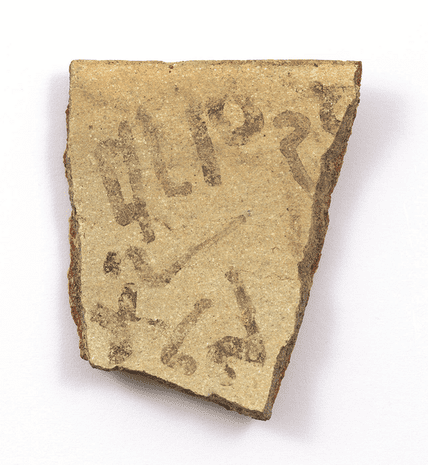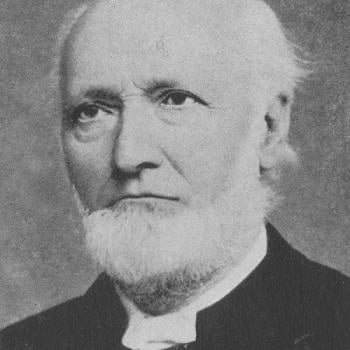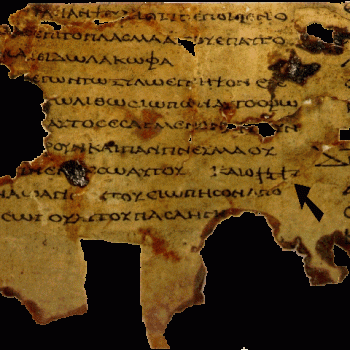+ a Plausible Scenario for Moses Gaining Knowledge of Hittite Legal Treaties in His Egyptian Official Duties

Kenneth A. Kitchen, eminent Egyptologist and archaeologist, summarizes the evidence for an early form of Hebrew or proto-Hebrew prior to Moses, and a plausible written Pentateuch by his time (possibly written by him):
The starting point is that the patriarchal narratives do retain much data faithfully preserved from the early second millennium [Dave: see many examples in a recent paper of mine: with a long citation from Kitchen]. A tenacious oral transmission to later times is possible . . . at least to start with. But written records are the securer route in most cases. . . . In Egypt two options then existed. The first, widely practiced, was Egypt’s own hieroglyphic and hieratic scripts. We have already met Semites using it by circa 1600 [BC], namely, Abdu on his coffin and Nahman on a dagger . . . In the large household of Potiphar, Joseph would either become trained in these scripts himself or work with scribes using them (compare Papyrus Brooklyn 35.1446 of ca. 1730, listing over forty Semites among seventy servants in such a household). But unless he trained some of his (or his brothers’) offspring to read these scripts, any patriarchal tradition in them would have become (literally!) a closed book to their descendants before Moses’ time.
The other option was the recently invented West Semitic alphabet, a vehicle deigned by and for Semitic speakers (and writers). The oldest known examples have been the Lachish dagger epigraph from a seventeenth century tomb and the Tell Nagila sherd (Middle/Late Bronze, ca. 1600); we now have also the Wadi Hol graffiti in Egypt from northwest of Thebes, about the seventeenth century. These oldest examples occur in homely, informal contexts, showing that it could be, and was, readily utilized by anyone who cared to do so, and not solely by government elites. To these must be added the proto-Sinaitic inscriptions of disputed date — circa 1800 or circa 1500. This system of not more than thirty simple, semipictographic letters would have been very easy to use in writing up (on papyrus) a “first written edition” of the patriarchal traditions from Abraham to Jacob, to which a Joseph account could be added. This set of basic narratives could then be recopied from circa 1600 to the thirteenth century, then given a “late Canaanite” editing in that phase of the script, eventuating into early standard Hebrew language and script from the united monarchy [c. 1000 BC] onward. At the Late Bronze (e.g., “land of Rameses”), Early Iron IIA (e.g., Laish > Dan), and final phases of transmission (e.g., “Chaldean” Ur), the handful of retouches would be incorporated. This straightforward view is at least consistent with all the factual data that we currently possess, and keeps theorizing to a minimum. (On the Reliability of the Old Testament, Grand Rapids and Cambridge: William B. Eerdmans Publishing Company, 2003, 370-371)
Elsewhere in the same book, Kitchen addresses the topic of the plausibility of Moses, or someone like him, writing much of the Pentateuch. I believe that the life and death dates of Moses were c. 1370-c. 1250 BC, extrapolating from the data in the article, “Moses” in Encyclopedia Britannica. Dr. Kitchen makes his extra-biblical case:
[T]o explain what exists in our Hebrew documents we need a Hebrew leader who had had experience of life at the Egyptian court . . . including knowledge of treaty-type documents and their format, as well as of traditional Semitic legal/social usage more familiar to his own folk. In other words, somebody distressingly like that old “hero” of biblical tradition, Moses, is badly needed at this point, to make any sense of the situation as we have it. . . . On the basis of the series of features in Exodus to Deuteronomy that belong to the late second millennium and not later, there is, again, no other viable option. (Ibid., 295)
Exod. 2:10 notes the full adoption of the boy [Moses] by his princess patron; that implies his becoming a member of the ruling body of courtiers, officials, and attendants that served the pharaoh as his government leaders under the viziers, treasury chiefs, etc. Such a youth would need to be fully fluent in Egyptian (not just his own West Semitic tongue); so he would be subjected to the Egyptian educational system, learning the hieratic and hieroglyphic scripts. This is typical enough during the New Kingdom, especially in the Nineteenth (Ramesside) Dynasty of the thirteenth century. . . .
Both Sethos I [r. c. 1290-1294-1279 BC] and Ramesses II signed treaties with the Hittite kings; the surviving one of Ramesses I shows the format so familiar in the whole “Hittite” corpus. What is more, the documents in this case were not just sent to Egypt by the Hittites for Egypt’s approval. The scribes at both courts produced drafts to be exchanged for mutual approval or amendment before the final document was settled. So anyone in Egypt’s “foreign office” would be able to learn of such documents in this epoch. . . . This . . . does explain how a Hebrew leader might later come to use this convenient and appropriate framework for the Sinai covenant.(Ibid., 297-298)
As for the role of a Moses, there is no factual evidence to exclude such a person at this period, or his having played the roles implied in Exodus to Deuteronomy. A large amount of inconclusive discussion by biblical scholars in almost two hundred years has established next to nothing with any surety . . . The basic reason for the endless shilly-shallying and lack of real result is the massive failure to seek and use external, independent controls such as have been applied here and throughout. Merely churning over and over the biblical texts exclusively in terms of subjective opinion will never be able to settle anything. (Ibid., 299)
[S]pecific books such as Deuteronomy and Joshua (and precursors such as Exodus and Leviticus) . . . could not then have been written in classical, standard biblical Hebrew as we know it in the present-day Hebrew Bible . . .
But in what form and language? . . . from the fourteenth/thirteenth century onward, the [Canaanite] alphabet could be freely used for any form of communication. The contemporary north Semitic texts found at Ugarit in north Phoenicia illustrate this to perfection . . . the Amarna evidence [c. 1360-1332 BC] and handful of pottery finds prove clearly that Canaanite was the dominant local tongue and could be readily expressed in alphabetic writing . . . Thus we should consider a Moses or a Joshua writing on papyrus, skins, or even waxed tablets in alphabetic late Canaanite. During the two centuries that followed, circa 1200-1000, standard Hebrew evolved out of this form of Canaanite, probably being fully formed by David’s time. Copies of older works such as Deuteronomy or Joshua would be recopied, modernizing outdated grammatical forms and spellings, a process universal in the ancient Near east during the period from 2500 to Greco-Roman times. (Ibid., 304-305)
The key concepts to understand from the above are the notions of 1) appropriation of existing cultural forms, and 2) the inherently evolving nature of language. Thus, many scholars inclined to be skeptical towards the bible will say things like “Hebrew didn’t exist until the 10th century BC; therefore, neither Moses nor anyone else prior to the 10th century could have written the Pentateuch.” This involves a disingenuous sleight-of-hand. It disregards ever-evolving language and also the universally accepted later editing and slight modifications (Grammar, spelling, changing geographical names, etc.) of the Bible.
Wikipedia (“Paleo-Hebrew alphabet”) makes the salient point:
Paleo-Hebrew script (Hebrew: הכתב העברי הקדום), also Palæo-Hebrew, Proto-Hebrew or Old Hebrew, is the name used by modern scholars to describe the script found in Canaanite inscriptions from the region of Biblical Israel and Judah. It is considered to be the script used to record the original texts of the Hebrew Bible due to its similarity to the Samaritan script, as the Talmud stated that the Hebrew ancient script was still used by the Samaritans. . . .
Like the Phoenician alphabet, it is a slight regional variant and an immediate continuation of the Proto-Canaanite script, which was used throughout Canaan in the Late Bronze Age. The Phoenician language, Hebrew language, and all of their sister Canaanite languages were largely indistinguishable dialects before that time. . . .
The Paleo-Hebrew and Phoenician alphabets developed . . . out of their immediate predecessor script Proto-Canaanite (Late Proto-Sinaitic) during the 13th to 12th centuries BCE, and earlier Proto-Sinaitic scripts.
Likewise, Wikipedia (“Proto-Sinaitic script”) concurs:
Proto-Canaanite is also used when referring to the ancestor of the Phoenician or Paleo-Hebrew script, respectively, before some cut-off date, typically 1050 BC, with an undefined affinity to proto-Sinaitic.
I list below various archaeological evidences of proto-Hebrew, paleo-Hebrew (pick your term) writing and use of the alphabet, before the time of Moses:
Newly deciphered Egyptian symbols on a 3,400-year-old limestone ostracon from Luxor’s Tomb of Senneferi appears to be the first written evidence of the ABC letter order of the early Semitic alphabet, according to a University of British Columbia Egyptologist.
In his article, “A Double Abecedary? Halaham and ‘Abgad on the TT99 Ostracon,” Prof. Thomas Schneider concludes that a small (approximately 10 x 10 centimeters, or about 4 x 4 inches) double-sided limestone flake was used by Egyptian scribes as a mnemonic device to remember the letter orders of not one, but two forms of early Semitic alphabets.
On one side of the flake is Schneider’s recent discovery: the transliteration into cursive Egyptian writing of the sounds that signify the beginnings of today’s Hebrew alphabet (Aleph, Bet, Gimel). On the other, a contemporary, though now lesser-known letter order, called “Halaḥam,” which was deciphered in 2015, on the same limestone flake, by Leiden University’s Dr. Ben Haring.
The limestone piece is dated to the Egyptian 18th dynasty, from the excavation of Theban Tomb 99 from the necropolis on the west bank of the Nile at Luxor, known as the Tombs of the Nobles. Director of the Cambridge Theban Tombs Project Dr. Nigel Strudwick found the object back in 1995, in what he calls “a later tomb shaft,” dating to about 1450 BCE. (“First written record of Semitic alphabet, from 15th century BCE, found in Egypt”, by Amanda Borschel-Dan, The Times of Israel, 5-22-18)
The origin of alphabetic script lies in second-millennium BC Bronze Age Levantine societies. A chronological gap, however, divides the earliest evidence from the Sinai and Egypt—dated to the nineteenth century BC—and from the thirteenth-century BC corpus in Palestine. Here, the authors report a newly discovered Late Bronze Age alphabetic inscription from Tel Lachish, Israel. Dating to the fifteenth century BC, this inscription is currently the oldest securely dated alphabetic inscription from the Southern Levant, and may therefore be regarded as the ‘missing link’. . . .*[T]he much-discussed Lachish Dagger . . . was discovered in 1934 by the British Expedition in tomb 1502, and dated to the late Middle Bronze Age (Tufnell 1958: 254). The bronze dagger exhibits four potential early alphabetic signs (Tufnell 1958: 128; Sass 1988: 53–54; Hamilton 2006: 390–91), and most scholars accept this interpretation (e.g. Albright 1948, 1969: 10; Naveh 1987: 26; Hamilton 2006: 303–4; Goldwasser 2006: 132, 2016: 140–42; Morenz 2011: 170–71; Lemaire 2017: 106; Haring 2020: 59). . . .*The new ostracon from Tel Lachish fills the gap between the potential early alphabetic writing on the late Middle Bronze Age Lachish Dagger and the corpus from the later Late Bronze Age phases. (“Early alphabetic writing in the ancient Near East: the ‘missing link’ from Tel Lachish” by Felix Höflmayer et al, Antiquity, Volume 95, Issue 381, June 2021, pp. 705 – 719; this article contains a wealth of information, with many links and a long bibliography)
On the track of an ancient road in the desert west of the Nile [Wadi el-Hol], where soldiers, couriers and traders once traveled from Thebes to Abydos, Egyptologists have found limestone inscriptions that they say are the earliest known examples of alphabetic writing.Their discovery is expected to help fix the time and place for the origin of the alphabet, one of the foremost innovations of civilization.
Carved in the cliffs of soft stone, the writing, in a Semitic script with Egyptian influences, has been dated to somewhere between 1900 and 1800 B.C., two or three centuries earlier than previously recognized uses of a nascent alphabet. The first experiments with alphabet thus appeared to be the work of Semitic people living deep in Egypt, not in their homelands in the Syria-Palestine region, as had been thought. . . .
“These are the earliest alphabetic inscriptions, considerably earlier than anyone had thought likely,” Dr. John Coleman Darnell, an Egyptologist at Yale University, said last week in an interview about the discovery.
“They seem to provide us with evidence to tell us when the alphabet itself was invented, and just how.” . . .
“Because of the early date of the two inscriptions and the place they were found,” said Dr. P. Kyle McCarter Jr., a professor of Near Eastern studies at Johns Hopkins University. “it forces us to reconsider a lot of questions having to do with the early history of the alphabet. Things I wrote only two years ago I now consider out of date.”
Dr. Frank M. Cross, an emeritus professor of Near Eastern languages and culture at Harvard University, who was not a member of the research team but who has examined the evidence, judged the inscriptions “clearly the oldest of alphabetic writing and very important.” He said that enough of the symbols in the inscriptions were identical or similar to later Semitic alphabetic writing to conclude that “this belongs to a single evolution of the alphabet.”
The previously oldest evidence for an alphabet, dated about 1600 B.C., was found near or in Semitic-speaking territory, in the Sinai Peninsula and farther north in the Syria-Palestine region occupied by the ancient Canaanites. These examples, known as Proto-Sinaitic and Proto-Canaanite alphabetic inscriptions, were the basis for scholars’ assuming that Semites developed the alphabet by borrowing and simplifying Egyptian hieroglyphs, but doing this in their own lands and not in Egypt itself. (“Discovery of Egyptian Inscriptions Indicates an Earlier Date for Origin of the Alphabet”, by John Noble Wilford, The New York Times, 11-13-99)
***
Photo credit: pottery sherd found at Lachish in southern Israel with proto-Hebrew alphabetic text, dating to 1450 BC [article in Haaretz / Antiquity Publications Ltd//J. Dye, Austrian Academy of Sciences]
***
Summary: Archaeological evidence shows an origin of a proto-ancient Hebrew alphabet as far back as 1800 BC, and various evidences suggest the plausibility of Moses writing the Pentateuch.
***
Tags: alphabet, ancient Egypt, ancient Hebrew, ancient Hebrew language, ancient Hebrews, Ancient Hebrews & writing, ancient Israel, ancient Israelites, ancient Jews, archaeology & the Bible, Bible & History, biblical accuracy, biblical archaeology, Bronze Age Canaan, Canaan, Canaanite language, Canaanites, evolution of language, Genesis, Hebrew alphabet, Hebrews, Holy Bible, Israelites & Hebrew, Israelites & writing, Moses, Paleo-Hebrew, Paleo-Hebrew alphabet, Pentateuch, Phoenicians, Proto-Sinaitic script, Torah, written Hebrew Bible, written Pentateuch













